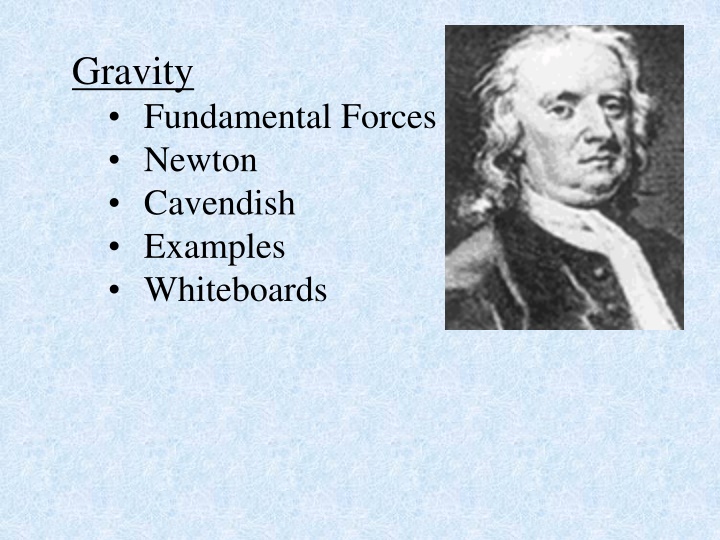
Gravity: Forces, Newton, Cavendish Examples
Delve into the world of gravity, exploring fundamental forces, Newton's discoveries, and Cavendish's contributions. Unravel the mysteries behind gravitational interactions, ranging from the weak to the strong forces that govern our universe.
Uploaded on | 1 Views
Download Presentation

Please find below an Image/Link to download the presentation.
The content on the website is provided AS IS for your information and personal use only. It may not be sold, licensed, or shared on other websites without obtaining consent from the author. If you encounter any issues during the download, it is possible that the publisher has removed the file from their server.
You are allowed to download the files provided on this website for personal or commercial use, subject to the condition that they are used lawfully. All files are the property of their respective owners.
The content on the website is provided AS IS for your information and personal use only. It may not be sold, licensed, or shared on other websites without obtaining consent from the author.
E N D
Presentation Transcript
Gravity Fundamental Forces Newton Cavendish Examples Whiteboards
Fundamental forces: Fundamental forces: Gravity Always attractive Very weak Acts on all mass Weak Nuclear Explains certain decays Acts in the nucleus Strong Nuclear Binds Nucleons Very strong Very short range Electro-Magnetic Attracts/repels Fairly strong (demo) Acts on charged particles
Neutrons glue massive nuclei Why there are not an infinite number of elements
Newton: Apple falls on his head? Newton knows four things: Distance apple is from the earth s center Distance it falls in a second Distance the moon is from the earth s center Distance it falls in a second 1643-1727 He concludes there is an inverse square relationship: F 1/r2
Newton: His law of universal gravitation so far: F = Gm1m2 r2 1643-1727 r What to use for G? m2 m1 r = Center to center distance m1 = One of the masses m2 = The other mass G = Universal gravitation constant
Cavendish Determines the value of G in 1798 F = Gm1m2 r2 Measures F, both masses, and r G = 6.67 x 10-11 Nm2/kg2 (units cancel)
F = Gm1m2 r2 r = Center to center distance m1 = One of the masses m2 = The other mass G = 6.67 x 10-11 Nm2/kg2 r m2 m1 Example 1 - Find the force of gravity between two 1.0 kg masses whose centers are exactly 1.0 meters apart? Example 2 - What is the force of gravity between a 1.0 kg mass, and the earth? (r = 6.38 x 106 m, mearth = 5.97 x 1024 kg) (check use of scientific notation) Sheet of everything - masses, radii, period of a day
Whiteboards: Gravity 1 | 2 | 3 | 4
What is the force of gravity between a 5.2 kg shot and a 250. kg wrecking ball whose centers are 2.45 m distant? F = Gm1m2 r2 1.44 x 10-8 N
Another shot is 1.45 m from the center of a 250. kg wrecking ball and experiences a force of 1.55 x 10-7 N, what is the mass of the shot? F = Gm1m2 r2 19.5 kg
What distance from the center of a 512 kg wrecking ball must a 4.5 kg bowling ball be to experience a force of 1.13 x 10-9 N? F = Gm1m2 r2 11.7 m
The moon has a mass of 7.36 x 1022 kg, and a radius of 1.74 x 106 m. What does a 34.2 kg mass weigh on the surface? F = Gm1m2 r2 55.5 N
The moon has a mass of 7.36 x 1022 kg, and a radius of 1.74 x 106 m. What mass weighs 25 N on its surface? F = Gm1m2 r2 15 kg
The moon has a mass of 7.36 x 1022 kg, and a radius of 1.74 x 106 m. At what distance from the moon s center would a 43 kg mass weigh 25 N? F = Gm1m2 r2 2.9 x 106 m
